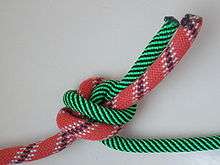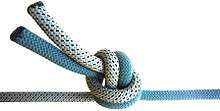Offset overhand bend
| Offset Water Knot | |
|---|---|
 | |
| Names | Offset Water Knot, European Death Knot (EDK), Offset overhand bend, Flat overhand bend, Thumb knot, Thumb bend, Creeler's knot, Openhand knot |
| Category | Bend |
| Origin | Ancient |
| Related | Overhand knot, Water knot |
| Releasing | Jamming |
| Typical use | sewing, weaving, baling, climbing, rappelling |
| ABoK | #246, #359, #1236, #1410, #1557, #1558, #3789 |
The offset overhand bend (ABoK #1410) is a knot used to join two ropes together. The offset overhand bend is formed by holding two rope ends next to each other and tying an overhand knot in them as if they were a single line. Due to its common use in several fields, this bend has become known by many names.
Uses
Easily formed in most line, the offset overhand bend is jam resistant at nominal loads of one person (i.e. approx 100kg). The jamming threshold is thought to be approximately 3kN (300kg). The instability threshold is thought to be approximately 5kN (500kg) - that is, a capsizing event becomes increasingly probable as loads approach 500kg. It is critically important to pay close attention to dressing and cinching of the knot before attempting to abseil. That is, climbers must exercise due diligence when tying this knot - by pulling firmly on each of the 4 rope segments - which is necessary to achieve a properly compacted and cinched dressing state. There is no room for carelessness when tying this knot.[1] Long used by weavers to join the ends of yarn, the offset water knot is very old. It was one of the knots likely identified among the possessions of Ötzi the Iceman, who dates from 3300 BC.[2] The knot is also tied in a slipped form by mechanical balers to bind straw and hay, but this bend is not practical to use as a binding knot when tied by hand.[3]
In climbing and mountaineering
In rock climbing, the offset water knot is a favored knot for joining two ropes for a rappel longer than half the length of the ropes. (Although it can fail by capsizing under high loads,[4][5][6][7] abseiling/rappelling doesn't generate such forces, and the knot, being on one side of the twin lines used in abseil, sees only half of this force.) American climbers, presumably believing the knot to be used only in hay bales or otherwise too vulnerable to flyping (inversion by capsizing), came to refer to it as the European Death Knot, abbreviated to EDK. In reality, such capsizing is actually highly unlikely, and with proper attention given to dressing and cinching the knot — the risk of capsizing is remote,[8] though failure of this knot has been implicated in at least once accident.[9][10]
Despite questions about this knot's security, it does present some advantages for use in rappels. Because the knot is offset from the axis of tension, it can translate more easily over rough surfaces and 90 degree edges than other knots; and it is quickly tied and readily untied. Since a stuck rope on a descent also represents a serious hazard to climbers, these advantages, along with ease of tying, have led to its popularity. It is recommended by some sources with the caveats that the tails be of sufficient minimum length (never less than 200mm), the knot be diligently dressed and fully tightened by pulling individually on all four rope segments, and then subjected only to moderate rappelling loads.[11]
Furthermore, #1410 (Offset overhand bend) can be rotated to induce a choking effect to trap and crush the tails. Virtually all testers appear to only examine this knot in its mid-rotation state. It is theorized that this mid-rotation state is in fact the orientation where the structure is most vulnerable to capsizing. A new round of testing is long overdue to investigate the potential benefits of rotating the structure to induce a choking effect. In addition, when tying the offset overhand bend using different rope diameters, the thinner diameter rope must be positioned underneath the larger diameter rope. This tactic further inhibits any likelihood of capsizing.

The Offset figure-eight bend, a similar knot using the figure-eight knot, has been used in the belief that its greater size and complexity brings more security. But testing and more than one fatal failure indicate the figure-eight variant to be less secure, more prone to capsize at lower loads, and in capsizing uses more of the ends than does a capsizing overhand bend.[8][11] Moreover, while there is one obvious proper dressing of the Overhand Bend, there are a couple of dressings for the Offset Figure Eight Bend.
See also
References
- ↑ Cyrus Lawrence Day (1986), The Art of Knotting and Splicing (4th ed.), Annapolis: Naval Institute Press, pp. 52–53
- ↑ van der Kleij, Gerre (1996), "On Knots and Swamps", in Turner, J.C.; van de Griend, P., History and Science of Knots, K&E Series on Knots and Everything, 11, Singapore: World Scientific Publishing, pp. 34–35, ISBN 981-02-2469-9
- ↑ Ashley, Clifford W. (1944), The Ashley Book of Knots, New York: Doubleday, p. 45
- ↑ "Flat Overhand Knot Pull Test With Wet Rope", YouTube (Video), Outdoor Pursuits - Campus Recreation at Auraria, 2014-09-15, retrieved 2018-07-10
- ↑ "Flat Overhand with Backup Knot Dry Pull Test", YouTube (Video), Outdoor Pursuits - Campus Recreation at Auraria, 2014-11-06, retrieved 2018-10-10
- ↑ "The Breaking Machine". Vimeo. 0:18 to 0:27. Retrieved 2018-10-10.
- ↑ Delaney, Richard (2012-04-15), "EDK Edelrid 11mm super static", YouTube (Video), retrieved 2018-10-14
- 1 2 Tom Moyer (1999-11-09), Rope and Gear Testing: Pull Tests of the "Euro Death-Knot"
- ↑ Magnuson, Mark. "Use of the Overhand Knot for Rappels". Cragmont Climbing Club. Retrieved 2018-07-10.
- ↑ Gaines, Bob; Martin, Jason D. (2014-05-20). Rock Climbing: The AMGA Single Pitch Manual. Rowman & Littlefield. p. 84. ISBN 9781493009626.
In one such rappelling accident in recent times (in the Tetons, September 1997), the flat overhand failed when it was sloppily tied with too short of a tail.
- 1 2 Soles, Clyde (2004), The Outdoor Knot Book, Seattle: The Mountaineers Books, pp. 125–127, ISBN 978-0-89886-962-0